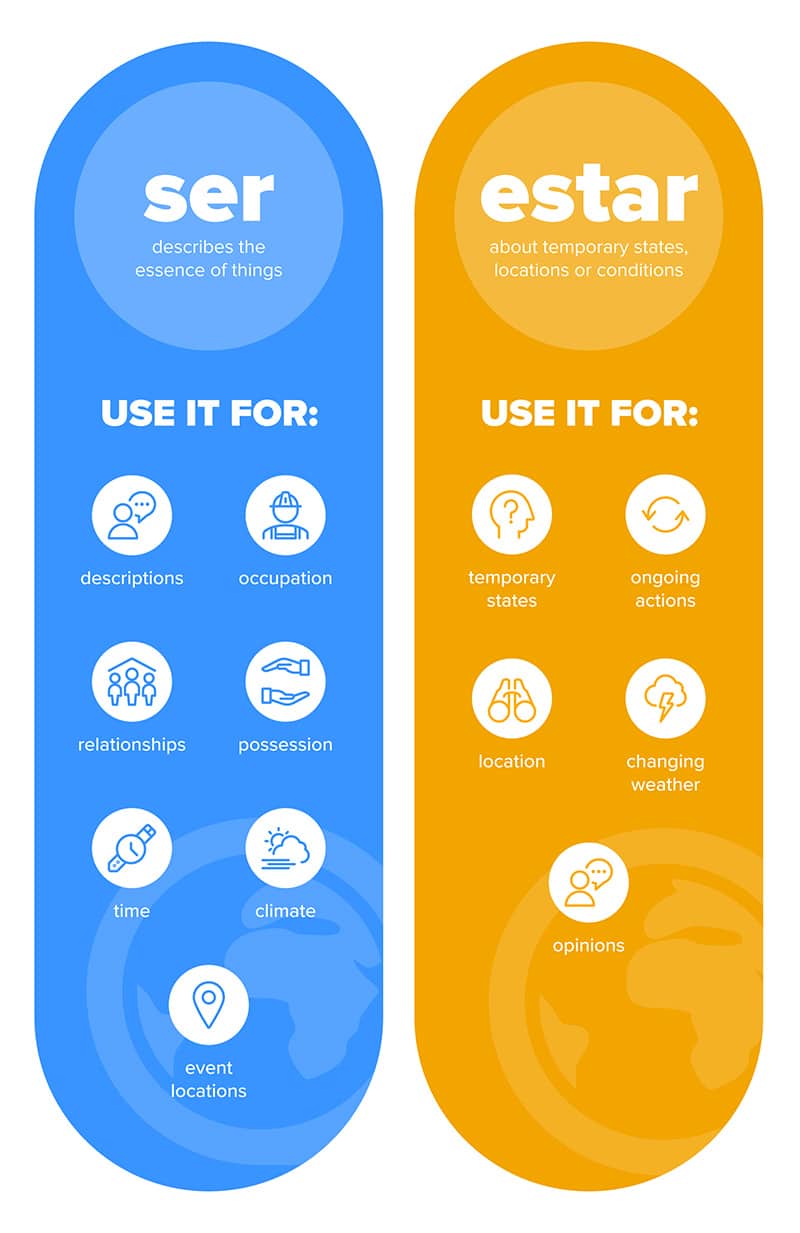
Differences Between Ser vs. Estar (Plus Examples)
One of the most common things that Spanish learners struggle with is how to tell the difference between two Spanish verbs that both mean “to be”: ser and estar.
Since two words have one meaning in Spanish, this is often a difficult aspect of Spanish to get down for many learners.
But have no fear. This guide will take you through how and when to use these two verbs in Spanish, and soon you’ll find choosing ser or estar comes naturally!
Contents
- The Difference Between Ser and Estar
- When to Use Ser
- When to Use Estar
- Why Is It Important to Use Ser and Estar Correctly?
- Common Mistakes with Ser and Estar
- Conjugating Ser and Estar
- Ser vs. Estar Quiz: Test Yourself!
- And One More Thing…
Download: This blog post is available as a convenient and portable PDF that you can take anywhere. Click here to get a copy. (Download)
The Difference Between Ser and Estar
Simply put, ser is used to describe the “essence of things”—the things that make something what it is and are unlikely to change—and estar is used to talk about temporary states, locations or conditions.
When to Use Ser
1. Descriptions
Ser is used for both physical descriptions and character descriptions or personality traits. It is also used to describe where someone is from and their nationality. The same rules apply for things.
- Ella es alta. (She is tall.)
- Ella es de Colombia. (She’s from Colombia.)
- La mesa es grande. (The table is big.)
Don’t forget to use the correct gender when using adjectives. If you’re a girl, you’ll probably want to use adjectives ending in “a” when describing yourself, if you’re a boy, go for “o.”
2. Occupation
A person’s job is also deemed to contribute to their “essence,” so we also use ser in this case. To ask someone what they do for a living, you can ask, “¿De qué trabajas?” , and you’ll receive the reply, “Soy + [their job].“
Note that you do not use the indefinite article un/una (a/an) when talking about jobs.
- Soy profesora. (I’m a teacher.)
- Soy abogado. (I’m a lawyer.)
3. Relationships
Ser is also used to describe relationships between people.
- Él es mi hermano. (He’s my brother.)
- Gustavo es mi novio. (Gustavo is my boyfriend.)
- Ella es mi amiga. (She’s my friend.)
4. Possession
When talking about things that belong to you or other people, you should always use ser.
- La casa es mía. (The house is mine.)
- Es mi libro. (It’s my book.)
- Estos zapatos son míos. (These shoes are mine.)
5. Time
We also use ser when talking about the time:
- Es la una. (It’s one o’clock.)
- Hoy es jueves. (Today is Thursday.)
- Hoy es el 21 de julio. (Today is July 21.)
- Mi cumpleaños es en mayo. (My birthday is in May.)
6. Event Locations
It is important to know that in most cases, estar will be used when referring to location, but not always. There is a case in which ser is used to refer to location, and that is when talking about where an event is going to take place.
- El concierto es en el estadio. (The concert is at the stadium.)
- Su boda será en Portugal. (Her wedding will be in Portugal.)
7. Climate (but Not Weather)
While ser is not used to describe day-to-day weather, it is used to describe the general climate of a place or time.
- El verano es caliente. (Summer is hot.)
- Florida es húmeda. (Florida is humid.)
When to Use Estar
1. Temporary States
Estar is used to describe temporary states such as temporary situations, or temporary physical and emotional states. This would include things like mood or sickness.
- Está feliz. (He is happy.)
- Estoy enferma. (I’m sick.)
- El café estaba caliente hace rato, pero ahora está frío. (The coffee was hot earlier, but now it’s cold.)
2. Ongoing Actions
The verb estar is also used to make the present continuous tense, which is used to describe actions happening in or around the moment of speaking.
These would be temporary actions or conditions that are only happening right now and are assumed to end within the near future.
To make this tense, you need the verb estar in the present tense before the stem of the verb plus “-ando” (-AR verbs) or “-endo” (-IR/-ER verbs).
estoy
estamos
estás
estáis
+ Verb stem + (-ando/-endo)
está
están
Examples are:
- Estoy hablando. (I’m talking.)
- Están comiendo. (They’re eating.)
- Estamos escribiendo. (We’re writing.)
3. Location
When describing where something or someone is, you also need to use our temporary friend estar.
- ¿Donde está Juan? (Where is Juan?)
- Está en el supermercado. (He’s at the supermarket.)
4. Weather
We use estar to describe weather when it is in a temporary state.
- Está frío. (It’s cold.)
- Estará nublado mañana. (It will be cloudy tomorrow.)
5. Opinions
We can also use estar as a descriptive adjective to express an opinion about the physical appearance of someone or something or to indicate that there is something unexpected about them.
-
Ese vestido está muy bonito. (That dress is so beautiful.)
-
¡Qué guapa estás hoy! (You are/look so beautiful today!)
-
Disculpe, mi sopa está muy salada. (Excuse me, my soup is too salty.)
Why Is It Important to Use Ser and Estar Correctly?
While they both technically mean the same thing, it is very important to know the difference between ser and estar so that you can say what you mean to say. Using the wrong form of “to be” can lead to misunderstandings and confusion.
There’s a big difference between being bored and being a boring person, and saying someone is good-looking or a good person.
The best way to pick up on this is by immersing yourself with authentic Spanish media like texts and videos. This will help you realize context and see how these differences are applied.
You can find a variety of helpful sources online or with language learning programs such as FluentU, which allows you to watch native Spanish clips and learn with learning tools.
FluentU takes authentic videos—like music videos, movie trailers, news and inspiring talks—and turns them into personalized language learning lessons.
You can try FluentU for free for 2 weeks. Check out the website or download the iOS app or Android app.
P.S. Click here to take advantage of our current sale! (Expires at the end of this month)

Seeing how these two verbs are used in context by native speakers will improve your Spanish, and get you one step closer to fluency.
Common Mistakes with Ser and Estar
Ser Aburrido/a vs. Estar Aburrido/a
Soy aburrido /a means “I’m boring.” This means your entire essence is boring, and you are a boring person. You might want to say es aburrido/a (he/she/it is boring) when describing someone or something, but don’t blame us if someone is insulted by this declaration.
Estoy aburrido /a translates to “I’m bored.” Notice that estar is used for temporary states and this expression demonstrates a temporary state of boredom.
Ser Feliz vs. Estar Feliz
Es feliz means someone is a happy person, whereas está feliz means someone is temporarily happy.
Both are useful, but it’s important to know the difference between a perpetually happy person and someone who is just temporarily satisfied.
Es Muerto vs. Está Muerto
In this case, you will only ever use está muerto (he’s dead). Always use estar to describe dead things or people.
Death is always seen as a temporary state, so es muerto will never be used.
La Fiesta Es vs. La Fiesta Está
As mentioned before, when describing where a planned event takes place we use ser and not estar, even though we’re describing location.
So la fiesta es en mi casa (The party’s at my house) is correct, even though we’re talking about the location of the party. The same applies to any pre-planned event such as meetings, weddings, or parties.
Keep in mind that when describing the party itself, we will indeed use estar: la fiesta está muy divertida. (The party is so fun).”
Es Bueno vs. Está Bueno
Está bueno/a translates to he/she is good-looking. This one is definitely useful in some contexts, but should probably be avoided in others.
If you want to say someone is good in general, use es bueno.
Conjugating Ser and Estar
Ser and estar are both considered irregular in Spanish, so it’s best to memorize them.
Here’s how they are conjugated in the main three verb tenses:
| Ser | Present | Preterite | Future |
|---|---|---|---|
| yo | Soy | Fui | Seré |
| tu | Eres | Fuiste | Serás |
| él, ella, usted | Es | Fue | Será |
| nosotros | Somos | Fuimos | Seremos |
| vosotros | Sois | Fuisteis | Seréis |
| ellos, ellas, ustedes | Son | Fueron | Serán |
| Subject | Present | Preterite | Future Simple |
|---|---|---|---|
| Yo | Estoy | Estuve | Estaré |
| Tú | Estás | Estuviste | Estarás |
| Él/Ella/Usted | Está | Estuvo | Estará |
| Nosotros | Estamos | Estuvimos | Estaremos |
| Vosotros | Estáis | Estuvisteis | Estaréis |
| Ellos/Ellas/Ustedes | Están | Estuvieron | Estarán |
Ser vs. Estar Quiz: Test Yourself!
Please select 2 correct answers
Although learning the difference between ser and estar can be difficult, it will come with time and practice.
With constant practice, you’ll know which circumstances require each type of “to be” in Spanish.
Download: This blog post is available as a convenient and portable PDF that you can take anywhere. Click here to get a copy. (Download)
And One More Thing…
If you've made it this far that means you probably enjoy learning Spanish with engaging material and will then love FluentU.
Other sites use scripted content. FluentU uses a natural approach that helps you ease into the Spanish language and culture over time. You’ll learn Spanish as it’s actually spoken by real people.
FluentU has a wide variety of videos, as you can see here:

FluentU brings native videos within reach with interactive transcripts. You can tap on any word to look it up instantly. Every definition has examples that have been written to help you understand how the word is used. If you see an interesting word you don’t know, you can add it to a vocab list.

Review a complete interactive transcript under the Dialogue tab, and find words and phrases listed under Vocab.

Learn all the vocabulary in any video with FluentU’s robust learning engine. Swipe left or right to see more examples of the word you’re on.

The best part is that FluentU keeps track of the vocabulary that you’re learning, and gives you extra practice with difficult words. It'll even remind you when it’s time to review what you’ve learned. Every learner has a truly personalized experience, even if they’re learning with the same video.
Start using the FluentU website on your computer or tablet or, better yet, download the FluentU app from the iTunes or Google Play store. Click here to take advantage of our current sale! (Expires at the end of this month.)








